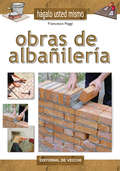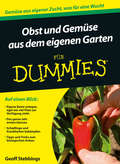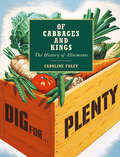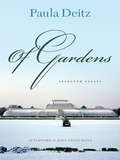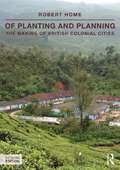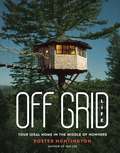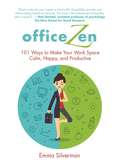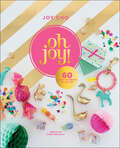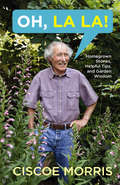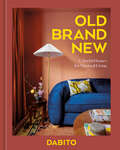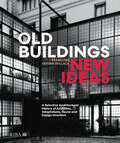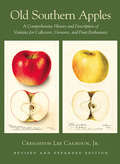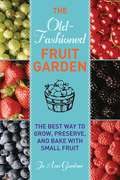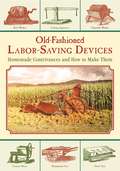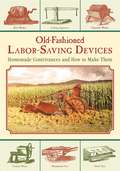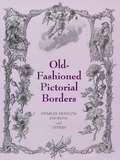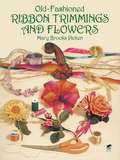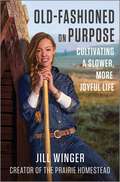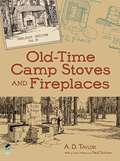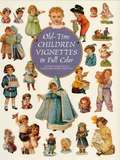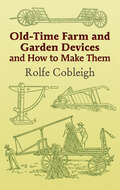- Table View
- List View
Obras de albañilería
by Francesco Poggi* Realizar en casa algunas obras de albañilería puede resultar fácil y divertido pero también, a veces, necesario: basta con seguir las instrucciones que se facilitan en este libro para que no encuentre ninguna dificultad en cualquier intervención que tenga que realizar. * Aprenderá todo sobre herramientas manuales y eléctricas, los distintos tipos de tacos y cómo utilizarlos, morteros de cal y cemento, muros, paredes divisorias, pavimentaciones externas, etc. * Una obra con la que aprenderá a construir con sus propias manos mesas, bancos, maceteros, barbacoas...
Obst und Gemüse aus dem eigenen Garten für Dummies (Für Dummies)
by Geoff StebbingsFrisches Obst und Gemüse aus dem eigenen Garten Mal eben in den Garten gehen und ein paar Beeren naschen, die selbst angebauten Bohnen ernten oder Zwetschgenkuchen mit Früchten vom eigenen Baum backen − gefällt Ihnen die Vorstellung? Dieses praktische Handbuch gibt Ihnen zahlreiche Tipps und Tricks, wie Sie das ganze Jahr lang leckeres, ernte - frisches Obst und Gemüse aus dem eigenen Garten genießen können: von der Wahl des Werkzeugs über die Auswahl der Pflanzen und Tipps zum biologischen Anbau bis zur ersten Ernte. Geoff Stebbings gibt Ihnen nützliche Ratschläge an die Hand, damit Sie sofort mit der eigenen Gartenarbeit beginnen können und in kurzer Zeit ein erfolgreicher Hobbygärtner werden.
Ode to Color: The Ten Essential Palettes for Living and Design
by Lori WeitznerInternationally renowned textile designer Lori Weitzner presents a novel, layered perspective on the use and significance of color in design and culture in this spectacular treasury illustrated with 225 full-color images.Ode to Color, a stunning anthology by renowned and award-winning textile and wallcovering designer Lori Weitzner, principal of Lori Weitzner Design, Inc., offers an immersive, sensual, and engaging journey in the world of color as it applies to culture, design, mood, and memory. Each of the ten chapters in this richly illustrated volume presents a distinct color world through an intimate and often kaleidoscopic perspective, a compilation of the numerous—and often shifting—associations and emotions we assign to a color or group of colors.Each chapter combines diverse imagery—evocative fine art and photography, environmental interiors, details of Weitzner’s gorgeous designs as well as her sketches and watercolors—with excerpts from literature and her own essays on a wide array of topics relating to the palette. The result is a fully sensory conveyance of each palette’s particular power as well as a consideration of its tangible and intangible connections, from its place in religion, pop culture, and commerce to the impact it has upon our decision making, our moods, and our tastes. While each chapter is unique in its approach to the ten worlds, with its mix of essays, prose and range of art, from a Technicolor Disney cartoon in Out Loud to David Bowie as Ziggy Stardust in Silverlight, each chapter includes: An introductory essay on a subject that characterizes the paletteA two-page photographer of an open drawer in Weitzner’s studio that she has arranged with various fabrics, skeins, and objects that, together, comprise the palette;An evocative two-page word collage that presents both color names and the words commonly associated with the palette;Design pointers that provide in-depth insight to working with color and to decorating with each palette throughout the home, from wall treatments to accessories. Spectacular and imaginative, this experiential volume will captivate, inspire, and inform a broad audience, including interior designers and decorators, architects, graphic and fine artists, and anyone interested in art, design, fashion, pop culture, and spiritual discovery. Sumptuous, beautifully designed, and filled with wondrous imagery and compelling stories and facts, it makes an inspiring and unusual gift for almost any occasion.
Of Cabbages and Kings: The History of Allotments
by Caroline Foley“An excellent account” of Britain’s tradition of parceling out land for the public to grow food on, and the colorful history behind it (The Independent).This lively book tells the story of the private garden plots known as allotments—from their origin in the seventeenth century, when new enclosures that deprived the peasantry of access to common lands were fiercely protested, to the victory gardens of the world wars, and into the present day, when they serve less as a means of survival than as a respite from the modern world. While delving into the effects of the Napoleonic Wars, the Corn Laws, and the utopian dissenters known as the Diggers, the author reveals the multiple roles of allotments—and champions their history in the hope of protecting them for the future. “Foley’s book reminds us that the right to share the earth has always been an asymmetric struggle.” —The Guardian“Fascinating and handsomely illustrated.” —Daily Mail“Well-told . . . . [a] gallop through the history of useful rather than ornamental crops.” —Spectator Australia
Of Gardens
by Paula DeitzPaula Deitz has delighted readers for more than thirty years with her vivid descriptions of both famous and hidden landscapes. Her writings allow readers to share in the experience of her extensive travels, from the waterways of Britain's Castle Howard to the Japanese gardens of Kyoto, and home again to New York City's Central Park. Collected for the first time, the essays in Of Gardens record her great adventure of continual discovery, not only of the artful beauty of individual gardens but also of the intellectual and historical threads that weave them into patterns of civilization, from the modest garden for family subsistence to major urban developments. Deitz's essays describe how people, over many centuries and in many lands, have expressed their originality by devoting themselves to cultivation and conservation.During a visit to the Abby Aldrich Rockefeller Garden in Seal Harbor, Maine, Deitz first came to appreciate the notion that landscape architecture can be as intricately conceived as any major structure and is, indeed, the means by which we redeem the natural environment through design. Years later, as she wandered through the gardens of Versailles, she realized that because gardens give structure without confinement, they encourage a liberation of movement and thought. In Of Gardens, we follow Deitz down paths of revelation, viewing "A Bouquet of British Parks: Liverpool, Edinburgh, and London"; the parks and promenades of Jerusalem; the Moonlight Garden of the Taj Mahal; a Tuscan-style villa in southern California; and the rooftop garden at Tokyo's Mori Center, among many other sites.Deitz covers individual landscape architects and designers, including André Le Nôtre, Frederick Law Olmsted, Beatrix Farrand, Russell Page, and Michael Van Valkenburgh. She then features an array of parks, public places, and gardens before turning her attention to the burgeoning business of flower shows. The volume concludes with a memorable poetic epilogue entitled "A Winter Garden of Yellow."
Of Planting and Planning: The making of British colonial cities (Planning, History and Environment Series)
by Robert Home‘At the centre of the world-economy, one always finds an exceptional state, strong, aggressive and privileged, dynamic, simultaneously feared and admired.’ - Fernand Braudel, Civilization and Capitalism, 15th–18th Centuries This, surely, is an apt description of the British Empire at its zenith. Of Planting and Planning explores how Britain used the formation of towns and cities as an instrument of colonial expansion and control throughout the Empire. Beginning with the seventeenth-century plantation of Ulster and ending with decolonization after the Second World War, Robert Home reveals how the British Empire gave rise to many of the biggest cities in the world and how colonial policy and planning had a profound impact on the form and functioning of those cities. This second edition retains the thematic, chronological and interdisciplinary approach of the first, each chapter identifying a key element of colonial town planning. New material and illustrations have been added, incorporating the author's further research since the first edition. Most importantly, Of Planting and Planning remains the only book to cover the whole sweep of British colonial urbanism.
Off Grid Life: Your Ideal Home in the Middle of Nowhere
by Foster HuntingtonBestselling Van Life author Foster Huntington shares his experiences - as well as others - living by his own rules in this aspirational book filled with awe-inspiring photographs of unique homes in unexpected places.After spending three years on the road living in a camper van, Foster Huntington continued his unconventional lifestyle by building a two-story treehouse. Foster, like many others, are finding freedom, tranquility, and adventure in living off the grid in unconventional homes.Perfect for fans of Van Life and Cabin Porn and those who yearn for a simpler existence, Off Grid Life showcases unique dwellings from all around the world. Organized into sections like tree houses, tiny houses, shipping containers, yurts, boathouses, barns, vans, and more, the 250 aspirational photographs feature enviable settings like stunning beaches, dramatic mountains and picturesque forests. Also included are images of fully designed interiors with kitchens and sleeping quarters as well as interviews with solo dwellers, couples, and families who are living lives off the beaten path.
Off Grid Life: Your Ideal Home in the Middle of Nowhere
by Foster HuntingtonBestselling Van Life author Foster Huntington shares his experiences -- as well as others -- living by his own rules in this aspirational book filled with awe-inspiring photographs of unique homes in unexpected places. After spending three years on the road living in a camper van, Foster Huntington continued his unconventional lifestyle by building a two-story treehouse. Foster, like many others, are finding freedom, tranquility, and adventure in living off the grid in unconventional homes. Perfect for fans of Van Life and Cabin Porn and those who long for a quieter life, Off Grid Life showcases unique dwellings from all around the world. Organized into sections like tree houses, tiny houses, shipping containers, yurts, boathouses, barns, vans, and more, the 250 aspirational photographs feature enviable settings like stunning beaches, dramatic mountains and picturesque forests. Also included are images of fully designed interiors with kitchens and sleeping quarters as well as interviews with solo dwellers, couples, and families who are living this new American dream. p.p1 {margin: 0.0px 0.0px 0.0px 0.0px; font: 14.0px Calibri} p.p2 {margin: 0.0px 0.0px 0.0px 0.0px; font: 14.0px Calibri; min-height: 17.0px}
Off the Grid: Inside the Movement for More Space, Less Government, and True Independence in Modern America
by Nick RosenRosen is a writer and documentary filmmaker who earned his off the grid wings living in a homemade RV in Britain. In this work he travels to the US to document the living off the grid scene by interviewing people of all types and socio-economic groups that have decided, partially or wholly, to live without connection to municipal power and water services. These case studies illuminate the different types of Americans who choose to live this way and the varied arrangements possible within that scope. Right-wing militants eager to keep out of the government's gaze, original or neo-hippies desiring some peace and quiet in a tree house or the new, like-minded family ties of a commune are among the extremes highlighted as Rosen crisscrosses America cataloguing this small but growing trend. With the recession, job losses, and frequent foreclosures, this book should appeal to anyone at all, especially those looking for, as the title says, "more space, less government, and true independence". Annotation ©2010 Book News, Inc. , Portland, OR (booknews. com)
Office Zen: 101 Ways to Make Your Work Space Calm, Happy, and Productive
by Emma SilvermanYou do not need to climb to the top of the coldest, highest mountain to be Zen. You do not need to crawl on your hands and knees, seal yourself away in a cave, or stop eating birthday cake. Most importantly, at least for this book, you do not have to quit your job to be Zen. In Office Zen, you will learn how Zen can exist in any moment and any place, even the most stressful and high-strung office.Office Zen will be the first book to incorporate the Zen principles of mindfulness and simplicity into the home office and work station byproviding tips on how to remove clutter from your work spaceteaching meditation and stretching exercises to destress in two minutes or lesslaying the frame work for a healthy work-life balanceZen, and other mindfulness practices like it, asks us to examine the world around us with an emphasis on kindness and compassion toward ourselves and others. By being more meditative and calm in your daily interactions, you can bring peace into your workplace and happiness into your life.
Oh Joy!: 60 Ways to Create & Give Joy
by Joy ChoA beautiful, joyful, colorful, gifty guide to living in style, from home to food to fashion, from the popular blogger with the world’s biggest Pinterest following—14 million!—and a line of products at Target. Fourteen million Pinterest members look to Joy Cho, a designer, blogger, mother, and founder of the Oh Joy blog, for creative inspiration. Now, she builds on that success to offer a cornucopia of new ideas in this simple yet sophisticated full-color book. Following the unique aesthetic and joyful tone of her blog, Oh Joy! shows you how to add style, detail, color, flavor, and bliss into your daily life. For Joy, it’s the small things that can make a big impact, like decorating cakes with fun toppers, or brightening your home with vibrant pops of color. Joy wants to help you make your world a happier, prettier place and her boundless enthusiasm is infectious. Oh Joy! is packed with quick, easy, and fun projects and fabulous notions for:Fashion: tips for mixing patterns or finding unique pieces at vintage storesDécor: make your own wallpaper and use artificial flowers in unexpected waysEntertaining: suggestions for quirky centerpieces and photo booth backdropsFood: Recipes for striped cakes, surprise confetti cookies, and other bite-sized foodsGifts: Spread the joy with personalized lottery tickets and pop-up wrapping paperIncorporate beauty into the things you do—make your everyday life feel more colorful, fresh, and fun—and get an intimate, gorgeous look into the world of Joy Cho with Oh Joy!
Oh, La La!: Homegrown Stories, Helpful Tips, and Garden Wisdom
by Ciscoe MorrisThe most beloved and respected gardening expert of the Pacific Northwest, Ciscoe Morris, entertains us with gardening stories and shares advice, information, and wisdom from a career that has spanned 45 years and is still going strong.With heart and humor, Ciscoe Morris regales us with stories from the gardens he has tended, the wildlife he has encountered--deer, moles, rats, birds, and more--the dogs who have joined him on his travels, the secret lives of insects, and his endeavors as head gardener at Seattle University. Each story will make you smile but will also contain a nugget of gardening wisdom or a practical, helpful tip that home gardeners will be able to put to use in their own gardens.
Old Brand New: Colorful Homes for Maximal Living [An Interior Design Book]
by DabitoNATIONAL BESTSELLER • A deeply personal and compassionate look at home ownership and rentership through more than 50 rooms designed by interior designer, photographer, and Instagram star Dabito. &“Dabito&’s work is sculptural and beautiful—everything feels like an art piece! It is elevated yet functional—my fave combo.&”—Jessica AlbaDesigner, photographer, artist, blogger, and passionate vintage hunter Dabito is beloved on social media for his creative use of color, space, and maximalist design style. Old Brand New offers readers actionable advice to layer spaces with meaning through refreshing décor and bold hues, whether you&’re signing a lease or renovating or buying your first home. Illustrated with photographs of Dabito&’s many design projects and inspiring snaps from his travels, this book&’s chapters are each supplemented with how-to guides for weekend-friendly projects large and small. He includes helpful advice on hanging a gallery wall to styling bookshelves, repurposing furniture, and designing a vacation-inspired outdoor patio space. Along with easy daylong projects, Dabito also tackles deep renovations, with his down-to-the-studs ADU (accessory dwelling unit) project in Los Angeles where he changed an awkward laundry and storage room into his dream guest house. The power color alchemist also provides failproof color palettes for achieving a cohesive color story in your own space.In this deeply personal book, Dabito draws on his family&’s immigrant experiences to discuss the challenges he&’s faced finding a sense of security through designing his personal surroundings. Providing a new perspective on homeownership and rentership, Dabito reaches and empowers readers who rarely feel spoken to. Through his love of design, color, and maximalism, Dabito offers much-needed insight to the value of home and the meaning of family.
Old Buildings, New Ideas: A Selective Architectural History of Additions, Adaptations, Reuse and Design Invention
by Françoise Astorg BollackSome architectural transformations are modest, some are revolutionary. Shining a light on the hidden side of the accepted narrative of the history of architecture, this book explores works which transform existing buildings to build a way forward, through adaptations, additions and visual shifts. Examining 30 buildings across Europe, North America and South America, spanning from the early Middle Ages to the end of the 20th century, it demonstrates the creative possibilities of working with existing buildings. The book reveals how formal inventions can shape architecture and our environment over time in a built world constantly in a state of becoming. As we face a climate emergency, it taps into our deep cultural knowledge about the inventive use and re-use of buildings. Generously illustrated with architectural plans and over 300 colour images, it provides an alternative to the dominant view which sees conservation and preservation of historic buildings as a 20th century creation.
Old Southern Apples
by Creighton Lee CalhounA book that became an instant classic when it first appeared in 1995, Old Southern Apples is an indispensable reference for fruit lovers everywhere, especially those who live in the southern United States. Out of print for several years, this newly revised and expanded edition now features descriptions of some 1,800 apple varieties that either originated in the South or were widely grown there before 1928. Author Lee Calhoun is one of the foremost figures in apple conservation in America. This masterwork reflects his knowledge and personal experience over more than thirty years, as he sought out and grew hundreds of classic apples, including both legendary varieties (like Nickajack and Magnum Bonum) and little-known ones (like Buff and Cullasaga). Representing our common orchard heritage, many of these apples are today at risk of disappearing from our national table. Illustrated with more than 170 color images of classic apples from the National Agricultural Library's collection of watercolor paintings, Old Southern Apples is a fascinating and beautiful reference and gift book. In addition to A-to-Z descriptions of apple varieties, both extant and extinct, Calhoun provides a brief history of apple culture in the South, and includes practical information on growing apples and on their traditional uses.
Old-Fashioned Fruit Garden: The Best Way to Grow, Preserve, and Bake with Small Fruit
by Jo Ann GardnerJo Ann Gardner and her husband, Jigs, have been farming for nearly four decades, specializing in fruit, dairy, and herb products. Jo Ann herself makes and sells seventy-five cases of jams, jellies, and preserves a year. She knows her subject well-and this breezy, delightful reissue of her classic text is a testament to the continued relevance of her years of gardening knowledge. Whether an old hand or a novice, you'll find The Old-Fashioned Fruit Garden enlightening and informative, not to mention enjoyable. In this updated and full-color edition of The Old-Fashioned Fruit Garden, Jo Ann takes you back to the basics.
Old-Fashioned Labor-Saving Devices
by Skyhorse PublishingThe practical, intriguing American devices contained in this handbook come from an era long before milking machines, pesticide sprayers, and industrial hay balers. Designed to speed and simply everything from making your own butter to protecting drain outlets to organizing and storing tools, the easy-to-make mechanisms you'll find here can be just as useful for today's farmer as they were for frontier homesteaders.Discover how to transform odds and ends-scraps of lumber from old building projects, leftover sections of barbed wire, the box spring sitting in the attic-into handy household implements. With the illustrated instructions here, you can make a movable nest for hens, a ribless boat, a contraption to extricate a mired animal, a farm cart with movable racks for larger roads, a wire fence tightener, a fruit picker, a grindstone set and frame, and much more. This book is perfect for the rancher, farmer, craftsman-anyone with a love of the rural life.
Old-Fashioned Labor-Saving Devices: Homemade Contrivances and How to Make Them
by Skyhorse PublishingThe practical, intriguing American devices contained in this handbook come from an era long before milking machines, pesticide sprayers, and industrial hay balers. Designed to speed and simply everything from making your own butter to protecting drain outlets to organizing and storing tools, the easy-to-make mechanisms you’ll find here can be just as useful for today’s farmer as they were for frontier homesteaders.Discover how to transform odds and ends-scraps of lumber from old building projects, leftover sections of barbed wire, the box spring sitting in the attic-into handy household implements. With the illustrated instructions here, you can make a movable nest for hens, a ribless boat, a contraption to extricate a mired animal, a farm cart with movable racks for larger roads, a wire fence tightener, a fruit picker, a grindstone set and frame, and much more. This book is perfect for the rancher, farmer, craftsman-anyone with a love of the rural life.
Old-Fashioned Pictorial Borders
by others Charles Francois Daubigny60 rare plates of pictorial borders -- all with space for text or a message -- depict floral garlands, cupids, scrollwork, as well as finely rendered scenes of salon parties, amorous couples, ardent suitors, lovely maidens, and other eye-catching vignettes. Superb royalty-free illustrations for artists, graphic designers, decoupeurs, and other craftworkers.
Old-Fashioned Ribbon Trimmings and Flowers
by Mary Brooks PickenThe art of fashioning decorative accents with ribbons is enjoying a revival among today's crafters, who find it the perfect way to add lovely touches to clothing, personal items, household accessories, and more.Reproduced from a rare vintage edition, this profusely illustrated how-to book describes how to fold and sew lengths of ribbon to create dramatic ruffles, bows, and bands. You'll also learn how to use ribbon to fashion appealing florals; daisies, chrysanthemums, rosebuds, violets, petunias, dahlias, sunflowers, and even complete bouquets. Then use these charming ribbon creations to trim a hat, decorate baby clothes and lingerie, add a luxurious touch to lampshades and cushions, or embellish shoes, baby carriages, blankets, coat hangers, and much more.Step-by-step instructions show you exactly how to proceed. No special talent, other than minimal sewing skill, is required to learn ribbon art techniques and experience the satisfaction of creating an attractive item for yourself, your home, or a special someone.
Old-Fashioned on Purpose: Cultivating a Slower, More Joyful Life
by Jill Winger"In a world where so many of us are craving a life of simplicity and meaning, Old-Fashioned on Purpose gives you the roadmap to rediscovering what really matters." —Hal Elrod, bestselling author of The Miracle Morning With a foreword from singer, songwriter, and New York Times bestselling author Rory FeekCreator of The Prairie Homestead blog and the Old-Fashioned On Purpose podcast Jill Winger reveals that the secrets to finding happiness today is by turning to the lost arts of the past When the pandemic hit in 2020, flour and vegetable seeds flew off the shelves. But homesteader and entrepreneur Jill Winger believes these longings for sourdough bread and fresh veggies are more than a trend. As our society races toward progress, we&’ve left something important behind. We are more connected than ever before, yet we&’re still feeling unfulfilled. In Old-Fashioned on Purpose, Winger shows how simplifying our lives and adopting retro skills such as gardening and handiwork can be the key to creating the happy and healthy life we&’re yearning for. Inside these pages, readers will learn: How to find joy in the kitchen (even if you hate to cook) Proven strategies for growing your own groceries The surprising stress-relievers that can be found in your backyard How to craft a more grounded routine and save money in the process Clever tips and creative DIYs to help you embark on your old-fashioned journey You don&’t have to live on a farm to cultivate a simpler life. This inspiring and practical book offers a powerful new sense of purpose, with plenty of tomatoes, chickens, and bread making along the way.
Old-Time Camp Stoves and Fireplaces
by Paul Dickson A. D. TaylorCreated during the Great Depression by the U.S. Forest Service, this guide was designed to provide environmental safety and maintenance advice for visitors to national forests and parks. Loaded with finely crafted drawings and plans for outdoor stoves and fireplaces, this manual offers a window into a bygone era of handyman activity as well as a wealth of still-useful information for building barbecue pits, chimneys, warming units, and other outdoor heating sources.Coverage includes considerations of general design problems and their solutions; discussion of detailed designs, from foundations to chimneys; construction materials, including iron, brick, concrete, stone, and sand; and specific types of camp stoves and fireplaces. Do-it-yourselfers interested in older construction techniques will find this volume a source of many tried-and-true ideas and methods.
Old-Time Children Vignettes in Full Color (Dover Pictorial Archive)
by Carol Belanger GraftonHandsome collection of 358 vignettes depicting Victorian-era youngsters singly and in pairs, outfitted in knee pants, high-top boots and ruffled dresses; carrying flowers and baskets of fruit, playing croquet and other games, cuddling animals, and much more. Splendid sourcebook for hobbyists; engaging royalty-free images for artists and designers.
Old-Time Country Wisdom & Lore: 1000s of Traditional Skills for Simple Living
by Jerry Mack JohnsonA grand encyclopedia of country lore by famed Texas folklorist Jerry Mack Johnson, covering water witching, maple syruping, weather wisdom, country remedies and herbal cures, cleaning solutions, pest purges, bird migrations and animal lore, firewood essentials, adobe making and bricklaying, leather working, plant dyes, farm foods, natural teas and tonics, granola, bread making, beer brewing and winemaking, jams and jellies, canning and preserving, sausage making and meat smoking, drying foods, down-home toys, papermaking, candle crafting, homemade soaps and shampoos, Christmas wreaths and decorations, butter and cheese making, fishing and hunting secrets, and much more.
Old-Time Farm and Garden Devices and How to Make Them
by Rolfe CobleighA splendid bit of rural Americana, Cobleigh's book shows how anyone with a little time and money can add a touch of authentic charm to their farm, house, or garden. First published nearly a century ago, this practical guide features dozens of projects, accompanied by some 200 illustrations. A simply written text not only tells how to mount an anvil, make a cheese press, and build hog houses, but also provides handy advice on splitting wood, testing seed corn, tying practical knots, sharpening scissors, and papering a room.From building a rose trellis to creating a bicycle-powered washing machine, readers will delight in this book’s abundance of enjoyable and useful projects. It’s perfect for novice craftworkers and die-hard fans of Yankee ingenuity.
